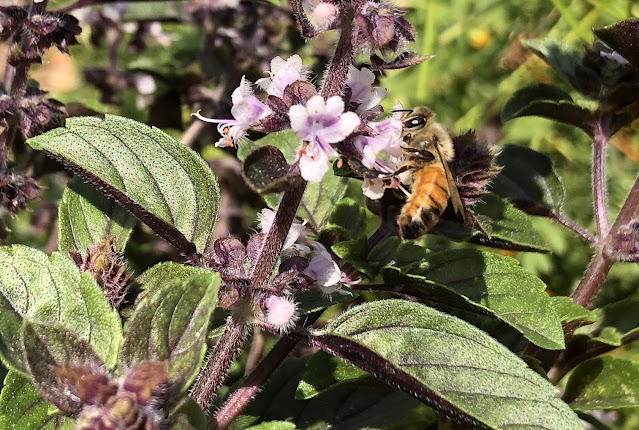
Take an active role in celebrating Pollinator Week

|
|
A honeybee lingers on a pollinator's flowering favorite: African blue basil. (Photo:
Kathy Morrison)
|
I never get tired of watching pollinators in action. The carpenter bees bending the branches of the "Hot Lips" salvia as they dig into the blossoms, the Anna's hummingbirds swooping into backyard to sample the hyssop, the fiery skipper butterflies landing delicately on matching orange zinnias.
And of course all those hard-working honeybees wiggling around in the squash flowers, producing more zucchini than I can eat. It's a busy world, the pollinator world, and we owe it thanks and assistance.
The Pollinator Partnership notes that about 75% of all flowering plants rely on animal pollinators and over 200,000 species of animals act as pollinators. Of those, about 1,000 are hummingbirds, bats, and small mammals. The rest are insects such as beetles, flies, bees, ants, wasps, butterflies, and moths.
Pollinator Week is an annual celebration in support of pollinator health that was initiated and is managed by Pollinator Partnership. Here is the PP's list of suggestions for gardeners who wish to have a pollinator-friendly garden (and who wouldn't?):
• Design your garden so that there is a continuous succession of plants flowering from spring through fall. Check for the species or cultivars best suited to your area and gradually replace lawn grass with flower beds.Some side notes from me on pollinators:
-- Remember that pollinators such as bees avoid extreme heat, too. During a heat spike, that means vine crops such as squash or melons are not getting pollinated. Take on a pollinator role yourself: Grab a watercolor brush or even a cotton swab and move pollen from the male flower (skinny stalk) to the female flower (tiny squash visible under the flower).
-- Don't deadhead every plant in your garden. Let some of them, especially the herbs, flower for the pollinators to enjoy. Chamomile, basil, parsley and cilantro flowers are some pollinator favorites.
-- Support the UC Davis Bee Haven . This wonderful outdoor museum and educational resource exists entirely on donations and volunteer work.
Comments
0 comments have been posted.Sacramento Digs Gardening to your inbox.
Sites We Like
Garden Checklist for week of May 12
Get your gardening chores and irrigation done early in the day before temperatures rise.
* Plant, plant, plant! It’s prime planting season in the Sacramento area. Time to set out those tomato transplants along with peppers and eggplants. Pinch off any flowers on new transplants to make them concentrate on establishing roots instead of setting premature fruit.
* Direct-seed melons, cucumbers, summer squash, corn, radishes, pumpkins and annual herbs such as basil.
* Harvest cabbage, lettuce, peas and green onions. This heat will cause leafy greens and onions to flower; pick them before they bolt.
* In the flower garden, direct-seed sunflowers, cosmos, salvia, zinnias, marigolds, celosia and asters.
* Plant dahlia tubers. Other perennials to set out include verbena, coreopsis, coneflower and astilbe.
* Transplant petunias, marigolds and perennial flowers such as astilbe, columbine, coneflowers, coreopsis, dahlias, rudbeckia and verbena.
* Keep an eye out for slugs, snails, earwigs and aphids that want to dine on tender new growth.
* Feed summer bloomers with a balanced fertilizer.
* For continued bloom, cut off spent flowers on roses as well as other flowering plants.
* Got fruit trees? If you haven't already done so, thin orchard fruit such as apples, peaches, pears, pluots and plums before they grow too heavy, breaking branches or even splitting the tree. Leave the largest fruit on the branch, culling the smaller ones, and allow for 5 to 6 inches (or a hand's worth) between each fruit.
* Thin grape bunches, again leaving about 6 inches between them. For the remaining bunches, prune off the "tail" end, about the bottom third of the bunch, so that the plant's energy is concentrated in the fruit closest to the branch.
* As spring-flowering shrubs finish blooming, give them a little pruning to shape them, removing old and dead wood. Lightly trim azaleas, fuchsias and marguerites for bushier plants.
* Add mulch to the garden to help keep that precious water from evaporating. Mulch also cuts down on weeds. But don’t let it mound around the stems or trunks of trees or shrubs. Leave about a 6-inch to 1-foot circle to avoid crown rot or other problems.